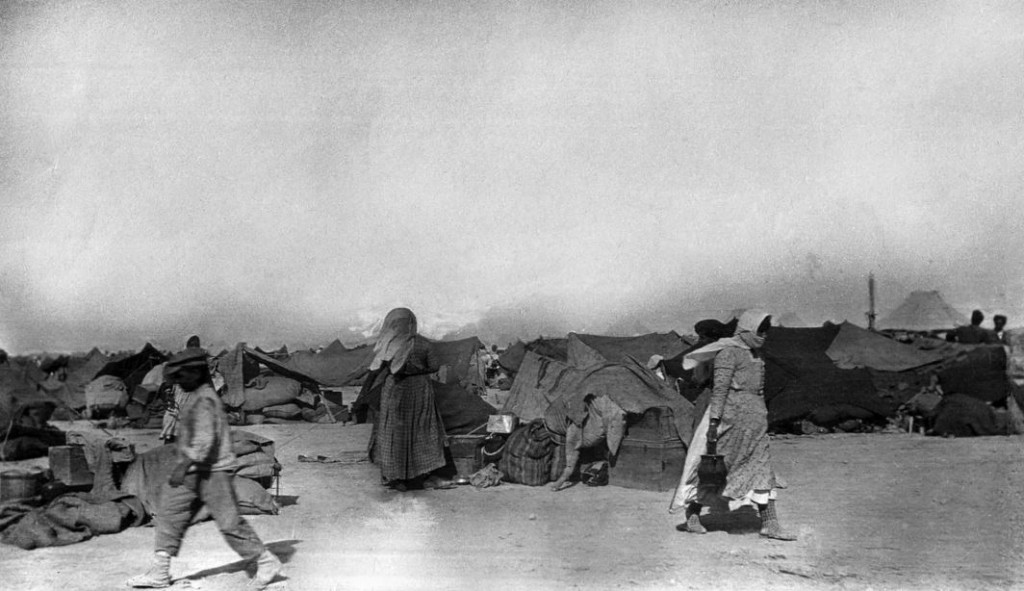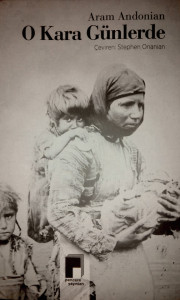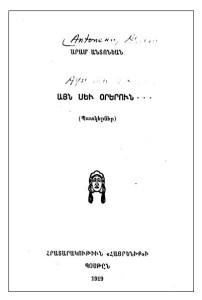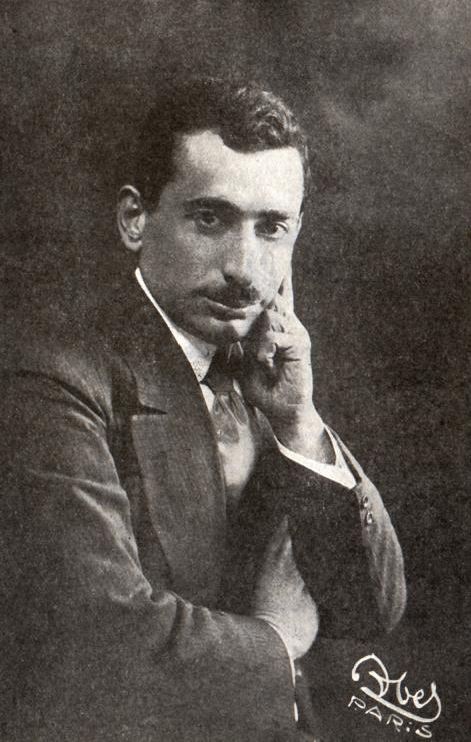Mouradian: The Book with a Black Cover
January 13, 2016
They arrived [in Meskeneh] by the thousands, but the majority left their bones there.
—Auguste Bernau, German employee
of the American Vacuum Oil Company[1]
ISTANBUL, Turkey (A.W.)—The Turkish translation of Aram Andonian’s monumental book Ayn Sev Orerun (In Those Black Days) was published in Istanbul this month by Pencere Publishing. Stephen Onanian translated the book; Atilla Tuygan copyedited it. Dr. Khatchig Mouradian wrote the introduction, the English version of which is reprinted below.
***
My first copy of Andonian’s Ayn Sev Orerun was a reprint issued in Beirut in 1985, on the 70th anniversary of the Armenian Genocide. It had a black cover with a drawing of a woman, in tears, next to a lyre.
I remember reading it as a teenager cover to cover, several times. The short stories were particularly jarring not only because of the horrid accounts and graphic details, but because page after page, the perpetrators were not named: The word “Turks” did not come up at all in the book.[2] Andonian did not name the victims either. The book had such a profound impact on me that to this day, every time I see that cover, sadness resurfaces.
And although thereafter I avoided reopening the book, I knew deep inside that it would have a fateful impact on my life.
Three years ago, I began writing my doctoral dissertation at Clark University on “Genocide and Humanitarian Resistance in Ottoman Syria, 1915-1917,” under the supervision of Prof. Taner Akçam. The work is now complete, with an entire chapter on the concentration camp in Meskeneh, where many Armenian deportees perished.
Not a day passed writing that chapter when I did not remember this book by Andonian—the woman who lost her mind upon the killing of her son, the deportees crying for water, the boy asking for his dead mother to wake up…
Twenty years after I first cracked the spine of the book, I knew I was writing about Meskeneh to honor the memory of that woman, those deportees, that boy…and a man called Aram Andonian, one of the very first to systematically document the crime.
Andonian
Aram Andonian (1879-1951) was a well-respected name in the literary circles of early 20th-century Constantinople as an editor and writer.[3] He was arrested on April 24, 1915, alongside many of his contemporaries, and sent to Çankırı. He left Çankırı in a convoy of 25 on Aug. 19, purportedly to be taken to Diyarbakir. On the way, as the convoy spent the night in a khan, he broke his leg and was forced to stay behind. The rest continued on their way and were killed near Elma Dağ, a few hours outside Ankara.[4]
The broken leg thus saved Andonian’s life. After recuperating in a hospital in Ankara, he headed to Tarsus. He was soon arrested, imprisoned in Konya, deported, rearrested, and eventually ended up in the Meskeneh in early 1916. His experiences there would, a few years later, culminate in this collection of short stories. After spending several months in Meskeneh, he escaped in June of the same year and sought refuge in Aleppo, where he enjoyed the support of the influential Mazloomian brothers, the owners of Hotel Baron. When the Mazloomians were exiled to Zahle, Andonian went with them, only to return to Aleppo after the Ottoman defeat in 1918.
Installing himself in post-war Aleppo, Andonian embarked on collecting shards of evidence and material on the destruction of the Armenians. His relationship with Ottoman official Naim Bey proved fateful. Andonian compiled the information and copies of telegrams he received from Naim Bey in his book The Great Crime.[5] An even more important contribution of Andonian’s to documenting the Armenian Genocide are the hundreds of survivor accounts and testimonies he collected in Aleppo in the immediate aftermath of World War I. Many of these accounts have been published by historian Raymond Kevorkian and used extensively in his work.[6]
Andonian took the telegrams and survivor accounts with him to Paris, where he worked for the Armenian National Delegation at the Peace Conference, headed by Boghos Nubar. In 1927, Nubar financed the building of a library to serve as a depository of the delegation’s archives and whatever could be saved of the Ottoman-Armenian cultural and literary heritage. Andonian served as the director of the Nubar Library until shortly before his passing.
Meskeneh
After arriving in Aleppo in 1915, the exiled Armenians were re-deported first to Meskeneh, and then farther downstream to Dipsi, Abuharar, Hamam, Rakka, Sebka, and Der Zor. Meskeneh became the final resting place for tens of thousands of deportees who died there from typhus, intestinal diseases, deprivation, and violence.

Listed as a transit camp in a September 1915 guideline organizing the re-deportation process of Armenians arriving in Syria, Meskeneh had operated as such from the onset of the deportations, but its importance grew with the closing of camps around Aleppo city in late 1915 and early 1916. (Photo: Armin Wegner, Mekhitarist Order, Venice, Italy)
Listed as a transit camp in a September 1915 guideline organizing the re-deportation process of Armenians arriving in Syria,[7] Meskeneh had operated as such from the onset of the deportations, but its importance grew with the closing of camps around Aleppo city in late 1915 and early 1916.
Meskeneh, situated at the great bend of the southern branch of the Euphrates River, was not much of a town in 1915. Accounts present it as “nothing more than a building, masquerading as an inn, a couple of miles from the course of Euphrates and hard against some bleak hills.”[8] There was also a telegram center near the khan on the western banks of the river.[9] Military barracks were under construction nearby when survivor Yeghisheh Hazarabedian arrived at the camp in early spring 1916.[10] “The whole thing was under the orders of a captain and his company who, when not working on the construction of the barracks, would live in the inn. Outside of the inn there were some 50 Armenian laborers who had volunteered to work on the project so that they would escape being driven farther down the river…to Deir ez-Zor,” he recounts.[11]
The camp where the deportees were interned was a 10-minute walk from the khan in the direction of the river.[12] In early 1916, as tens of thousands poured into Meskeneh, a large number of tents were erected on the heights overlooking the khan, while the area near the river was reserved for Armenians who were scheduled to be re-deported next.[13] By the end of 1916, as the camp was mostly emptied, camp director Hussein Avni moved the remaining deportees from the heights to the area near the Euphrates, which was less dusty in the dry gusty weather. The tents of the coachmen and the handymen were also moved and were erected on heights near the barracks.[14]
From April 1915 to April 1916, 110,934 deportees passed through Meskeneh, according to a document that Avni himself provided to Andonian after the war. The re-deported constituted 28,834 Armenians, while 80,000 died at the camp. The remaining 2,100 deportees were still at the camp in April 1916.[15] Thus, 72 percent of the deportees at the camp died on site. Auguste Bernau, a German employee of the American Vacuum Oil Company, visiting the camp in August-September 1916 to secretly distribute funds, provides a more conservative number: “Information collected on the spot allows me to confirm that around 60,000 Armenians were buried there,” he writes in a meticulous account of his journey.[16] Andonian points out that 300-500 people were dying in Meskeneh every day when he was there.[17] The numbers, as we have seen, are indeed staggering; roughly 1 out of 10 deportees arriving in Syria-Mesopotamia died in Meskeneh.
Most of those who survived Meskeneh did not fare better. The Ottoman authorities liquidated most of the camps along the Euphrates in the spring and early summer of 1916 and marched the deportees in the direction of Der Zor. There, a reinforced gendarmerie, alongside Circassian bands from the district, massacred around 200,000 deportees in the summer of 1916.
***

Andonian’s Ayn Sev Orerun (In Those Black Days) was published in Istanbul this month by Pencere Publishing.
As one of the few intellectuals who survived the arrests and eventual killings of Armenian community leaders arrested on April 24, 1915, and the weeks that followed, Andonian felt a responsibility to diligently collect testimonies and official documents on the Medz Yeghern (Great Crime), hoping that it would contribute to some form of justice after the war.
Although justice was not served, descendants of survivors of the Armenian Genocide passed on these accounts to their children and grandchildren. Teenagers picked up black-covered books like Andonian’s In Those Black Days, and carried with them the burden of the struggle against denial.
For those of us reading In Those Black Days in the Armenian Diaspora, seeing this book on the bookshelves in Turkey was a distant dream.
Notes
[1] DE/PA-AA; R14094; A 28162; Report from the Consul in Aleppo (Rossler) to the Imperial Chancellor (Bethmann Hollweg) on Sept. 27, 1916, in Wolfgang Gust, ed., The Armenian Genocide: Evidence from the German Foreign Office Archives, 1915-1916 (New York: Berhgahn, 2014), p. 653.
[2] Leading Armenian literary critic and novelist Hagop Oshagan calls this book an “undisputable eyewitness testimony,” and discusses the absence of the word “Turk” there in his 10-volume Panorama of Western Armenian Literature (Hamapatker Arevmdahay Kraganutyan). He writes, “Those dark days did not fall upon us from the dark sky. They were handmade by the Turks. The lack of any mention of Turks is obvious from the first pages but as the stories unfold it becomes maddening.” As cited in Rita Soulahian-Kuyumjian, The Survivor: Biography of Aram Andonian (London: Gomidas Institute, 2010), p. 21.
[3] For a detailed biography of Andonian, see Soulahian-Kuyumjian, The Survivor.
[4] Ibid., p. 15.
[5]Aram Andonian, Medz Vojire [The Great Crime] (Boston: Bahag Publishing, 1921). Abridged English and French editions of the book were also published in the same period.
[6] See Kévorkian, “L’Extermination des déportés arméniens ottomans dans les camps de concentration de Syrie-Mésopotamie, 1915-1916,” Revue d’histoire arménienne contemporaine, tome 2 (1998); and Kévorkian, The Armenian Genocide: A Complete History (New York: I.B. Tauris, 2011).
[7] BOA DH. EUM. 2. ŞB, 68/88 Copy of 56-article, meticulous guideline sent by IAMM Director Şükrü Kaya to the Ministry of Interior on Sept. 8, 1915.
[8] Account of survivor Yeghisheh Hazarabedian in Paren Kazanjian, ed., The Cilician Armenian Ordeal (Boston: Hye Intentions, 1989), p. 293.
[9] Zabel Yessayan and Hayg Toroyan, “Joghovurti me hokevarke (Aksoryal hayere michakedki mech)” [The Death Throes of a Nation: The exiled Armenians in Mesopotamia], Kordz, 3, 1917, p. 67.
[10] A map from the intelligence division of the British War Office updated in November 1915 already indicates the presence of barracks, as well as the positions of the khan and the telegram office there (marked as “post station”). See Meskeneh (London: British War Office, 1915).
[11] Ibid.
[12] Yessayan and Toroyan, “The Death Throes of a Nation.”
[13] Nubar Library Andonian Collection (Henceforth, BNu/Andonian), Folder 52b: “The camp directors of Meskeneh,” p. 74.
[14] BNu/Andonian, Folder 52b: “The camp directors of Meskeneh,” p. 74.
[15] BNu/Andonian, Folder 52b: “The corpses brought by the Euphrates,” p. 60.
[16] DE/PA-AA; R14094; A 28162; Report from the German Consul in Aleppo (Rossler) to the Imperial Chancellor (Hollweg) on Sept. 27, 1916, in Wolfgang Gust, ed., The Armenian Genocide: Evidence from the German Foreign Office Archives, 1915-1916 (New York: Berghahn, 2014), p. 653.
[17] Aram Andonian, Medz Vojire [The Great Crime] (Boston: Bahag, 1921), p. 19.
Source: Armenian Weekly
Link: Mouradian: The Book with a Black Cover

